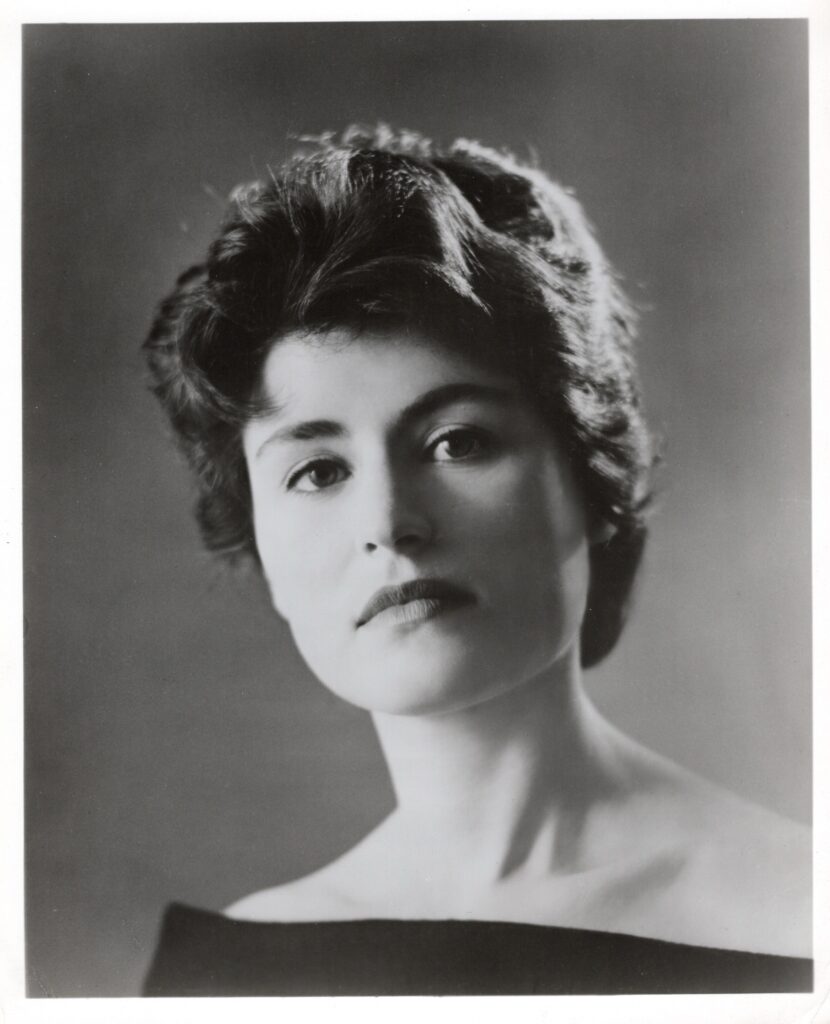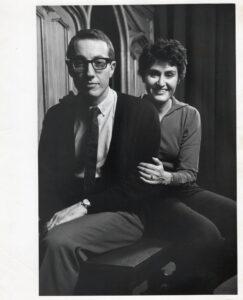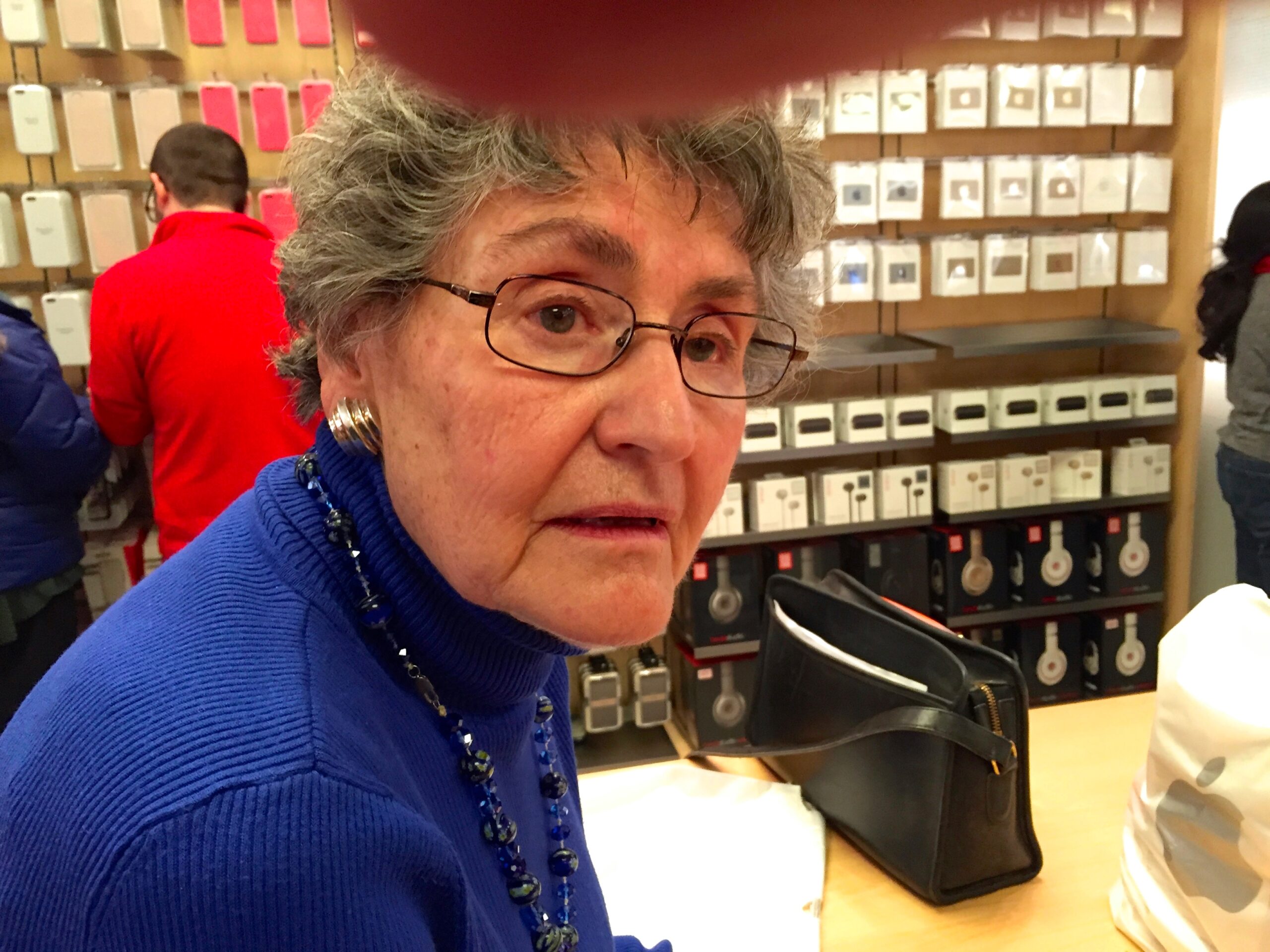
(1933-2025)
Eulogy
For Sandy Gagliano’s memorial, delivered by Frank Gagliano on 6 April 2025, at 2PM, at
Concordia Of The South Hills, Pittsburgh, 15243
FG
Hi. Thank you all for coming: Some family
(Sandy’s and mine) coming in from a distance; some friends, whom Sandy had touched, coming in from the Pittsburgh area. Welcome all.
So: Sandy—nèe Sandra Renèe Gorden— was my wife for 67 years—sharing a life of love, respect and an admiration of, and glorying in, each other’s artistry.
I first met Sandy at Queens College in New York. In the late 1940s. Both freshman. She from the Bronx—I, from Brooklyn.
Sandy’s cousin, Marvin Gorden— also a student at Queen’s College (and later –a well-known NY dancer and Choreographer) —was producing and directing the Varsity show that year.
I was auditioning for it.
Few others – also auditioning –were seated in the front row of the auditorium. When I finished my audition, I heard one of those girls in the front row say to the one next to her —clear and with real singer projection — “I can’t stand that guy’s voice.”
Sassy—yes! But gorgeous, too. –I had to meet her!
And once she got over my offensive vocal tremolo, and I was knocked out by her singing, we became part of the same Theatre/Music gang for the rest of our Queens College days together.
Fast forward: After college. I to my army days – (the Korean war). Then onto Columbia University – (on the G.I. bill) – for my MFA in playwriting. Then Sandy and I hook up again. Then marriage in 1958, by a justice of the peace, in Huntington, Long Island. Then, one honeymoon night at my uncle Jimmy’s Huntington house nearby. Then my going back to work at an NBC subsidiary in New York — Sandy, back to her daytime job at Time/Life magazine. Finally, starting our life together in our first East 77th Street, five-story walk up apartment in New York City.
SANDY had been a graduate of the prestigious High School of Music and Art in New York City. Voice major. Where she began learning classical bel canto vocal technique — and (as she would repeat throughout our marriage) “loved every minute of it —the vigorous training— the high expectations and demands from the gifted and encouraging faculty.” Apparently, she couldn’t wait to get to school from her home in the Bronx.
Later, she got a voice scholarship to the Chatham School of music in Manhattan. Then onto major voice teachers.
So—lo!—I had—among other things— married into the world of opera—to someone who was immersed in, and who gloried in, and had the understanding and smarts of, the opera singer’s voice-need for technique.
In the 1930’s, I had been brought up on Italian opera in my Italian/American family; on radio, on Italian stations; and listening, on Saturdays, to Italian opera, live from the old Metropolitan Opera house, that featured some of the greatest world singers. So I could hum major Opera Italian arias —but knew nothing more than that about opera. My passion, were the Great American Songbook composers and lyricists like Cole Porter, Irving Berlin, the Gershwins, Harold Arlen and (especially) Johnny Mercer.
By marrying Sandy —suddenly —I was now in a music world of French and German and Russian opera, plus Lieder composers and their great Lieder singers, and being mesmerized and dazzled and moved by Schubert, Schuman, Strauss, Faure, Debussy — and Sandy and I — together— were discovering great opera singers of the day, who illustrated and utilized the bel canto technique that Sandy was being taught, was learning— the technique of moving the voice, up to that High-C —seamlessly —and without breaks in the voice—in order to achieve —what the Italian’s called, “Sprezzatura,” — making something complex look/sound natural and effortless.
And so I was beginning to learn what real work in art was all about. And I began to explore whether I was digging out enough technique from my own work as a beginning playwright.
And so, marrying Sandy became my School of art. And so, we became from the start and throughout our 67 years – COLLABORATORS – searching together for the techniques we both needed for growing in both our arts.
And the collaboration had us seek out, and listen to, classical singers of the time, singers that neither of us had known .
I recall Sandy, excited, bringing home a recording of a Swedish Tenor, Jussi Bjorling. Knocked us out. Bjorling, effortlessly on that recording, singing an aria we had never heard before, “Nessun Dorma,” –nor had the world — Then! Early 1960s. From Puccini’s “Turandot,” an opera Sandy and I had never heard of— Then! And whenever Bjorling came to NY, we attended his solo concerts and some of his Metropolitan Opera Sprezzatura appearances.
And how did this opera world directly influence my playwriting?
Example: Working on a specific aria, Sandy would often say that it had a bitch of a “high tessatura.” Tessatura— a very high and difficult sustained vocal range throughout the piece. The word Tessatura —alone, though, inspired and tickled me and I created the mythical place, The High Tessatura’s—that l placed somewhere in the Caucasun Mountains. In my novel, “Anton’s Leap,” (still available, btw, on Amazon), a pivotal scene in the plot takes place in the mythical High Tessatura’s. And, In another short, comic, prose piece of mine, “Push/ Pull,” I had the main character, a spoiled prodigy violinist, come from that same High Tessatura Country.
Sandy might find interesting and amusing that I’m also thinking of writing a piece with a character named Tessie Tura — possibly a sassy drag-queen detective.
Also, I have on my back burner, a piece that could be built around an extended “Cabaleta,” A cabaleta is one of those bang up, charging ahead, ends of major dramatic arias that inhabit the world of Grand Opera. Verdi was a master ot the cabaleta. In my play, “In The Voodoo Parlour of Maria Laveau,” I end the prologue in a blackout with the thundering cabaleta from Verdi’s, IL Trovatore. Might even build an entire theatre piece AS a Cabaleta—a bang up, driving piece from beginning to end. Possible title: “The Cabaleta World Of Drag Queen Private Eye, Tessie Tura.” So many of my extant pieces end in a cabaleta now. I just didn’t know the technical word for it — before I entered into the opera world of my collaborator for life, Sandy, that is.
Sandy acted in stage plays, as well (my territory). I helped her on text analysis work when she was cast inThe Glass Menagerie and Crossing Delancy —at Washington and Jefferson
University, here, nearby, in Washington County. She was excellent in both. She put her Yiddish abilities to great use, as the Jewish grandmother in Crossing Delancy. And she did Tennessee Williams proud, I thought, with her performance as Amanda—a long, long role in which Sandy was letter perfect. Her memorization prowess, in fact, was prodigious—in those performances —and for her docent work for the Frick Mansion & Museum. . . .So sad—so sad to recall, by contrast, her inability to recall —just about anything— in her final dementia years.
And this irony, re Dementia: In the full production that Melissa Martin and Tammy Ryan —both here today—produced in Pittsburgh, in our early Pittsburgh days— of my musical revue, “From The Bodoni County Song Book Anthology—Sandy sang the caregiver’s role in the dramatic sketch, “A SONG OF LIFE (UN CONTO DI VITA) FOR ALZHEIMER MARY.”
Oh!—topic switch; There’s so much to say about our travels taken during 64 of those 67 pre- Dementia years:” In the UK, in Beijing, Shanghai. Sailing the Mediterranean on the Queen Victoria with Sandy’s brother Arnold and wife Bunny—to Greece, Turkey, Naples, Venice; other trips, on our own, to Paris, Germany, Florence; that Canadian train trip from Toronto to Vancouver; the magnificent African Safari, with Arnold and his family; high point there — viewing the animal migration from a Balloon. —The yearly back-and-forth trips to my family in California (Sandy loved my mother, my sister Nina, and my 5 nieces and nephews — two of whom are here today—Donna and Mathew)—And —oh—our moves from Florida to Texas to West Virginia— when I entered the Higher Education worlds and where —btw—besides being a wonderful mother to Rico—who was born in Tallahassee—Sandy always found a gifted Pianist In Residence to accompany her in concerts she —Sandy — would somehow promote —at Florida State U, at the University of Texas in Austin (where Sandy was also vocal couch on the PBS bi-lingual children’s program, “Carascolendas”), and in Morgantown, at West Virginia University.
Music was always being made in whatever house or apartment, in whatever City we were living in: —Sandy practicing — Sandy learning new scores. There were even full rehearsals being done, in whatever dwellings. A memorable one in our Mt. Lebonon house, was Sandy rehearsing, with a clarinetist and pianist, Schubert’s masterpiece, “Der Hirt Auf Dem Felsen” (“Shepherd On The Rock” —rehearsing for a concert at the JCC School of Music, here in Squirrel Hill.
So many memories flooding back: Tanglewood. That gig there—early in our marriage—where Sandy was singing one summer. I’d bus up to Tanglewood from NYC on weekends that summer. There, Sandy sang in a quartette for a performance—with the Boston Symphony— of Stravinski’s, “Les Noce.” Difficult piece. Exciting. She also was Canter here singing in a Monroeville Synogogue, regularly.
Remembering, too, the Sassy Sandy. This remembrance stands out. When my play, “NIght of the Dunce,” opened at Off Broadway’s Cherry Lane Theatre, in Greenwich Village, —produced by Edward Albee—at one performance, Sandy and I were seated behind a couple who were laughing and talking throughout. Soft shushes didn’t work. So Sandy smacked the guy’s head and in a stage whisper said, “stop it!” They did.
And I always wish I had been at this Sandy Sass session—(heard about it from a Sandy ally, who had been there). In Bejing, while I was teaching a playwriting class to English speaking Chinese students, Sandy was off with some visiting Americans she had met, shopping, and the visitors were being assholes to the sales people. Their bargaining tactics were insulting and embarassing, and Sandy called one out—in Yiddish—a schmegegge, and stalked away. Wish I had been there.
Finally: That O’Neill F&S Gagliano weekend, during early Sandy and Frank’s collaboration— some years BR (Before Rico).
In the summer of 1967, in Waterford, Conn, on the Long Island Sound, at The Eugene O’Neill Theatre Center for new play development, my play, “Father Uxbridge Wants To Marry” was being developed. And Sandy gave a concert in the Barn Theatre on the O’Neill’s closing afternoon that year.
The concert was recorded—but not well (an understatement). The barn was at an early stage of renervation —with no sound system—no recording equipment—and was very, very, very echoey. A temporary recording system was set up for the concert, but the mike could not get close to Sandy, thus favoring the piano. In addition, the recording person added echo to the recording.
Still. The Concert was a success. Sandy was in great voice. the content were heavyweight Arias and Lieder in English, German, French and Italian.
Here is one aria—“Quando M’en Vo” (flirt, Musetta’s waltz)—from Puccini’s, “La Boheme.”

Sandy singing a Puccini aria.
If only we had even one smart phone then! Besides recording Sandy better, one could make a video of the event and one could see her perform in the red gown that had been made for her. AND—she was lit by Broadway Lighting Designer Johnny Gleason! Gasp from the audience, when Sandy entered under Gleason’s stunning lighting—a singing flame throughout!
Five months later, my play, “Father Uxbridge Wants To Marry,” was produced off Broadway at the American Place Theatre, with Olympia Dukakis, giving her first stage performance, and

(Frank and Sandy —1967—on the Uxbridge set)
in which the soundtrack of a capella Bach arias were sung by soprano, Sandra Gagliano.
I close with two items: A poem (or lyric) I‘ve begun and —a goodbye song that Sandy got to love. She heard me use the song in the Endgame Cabaret I gave when I retired from West Virginia University, 15 years ago. It’s by Johnny Mercer, my favorite song writer of the Great American Songbook geniuses era. Mercer became Sandy’s favorite, too. And she got to love all the singers singing it that I had recorded, on my iTunes collection. I think she liked the cabaret singer, Karen Akers, the best.
The Johnny Mercer Song first: “How do you say auf wiedersehn”
“How do you say auf wiedersehn
To things we’ll never see again?
The Wilhelmstrasse in the rain,
The day we ran to catch the train,
That puffed along the river Seine.
—Remember Paris?
“And best of all the Pyrenes;
Who could forget such memories?
That crazy trip how typical of us
To miss the bus —the plane too.
How do you say auf wiedersehn to these?
“The wild times, the small things,
The popular waltz of the day. . .
It ended, as all things,
But when does the music go away?
. . .Say au revoir —but not good bye.
I said it till I want to cry.
“I wish someone could tell me what to do.
I wish I knew. . . .Ahh Sandy!
How do I say auf wiedersehn to you?”
* * * * * * * * * * * * * * * * * * * * * * * * * * * * *
Finally, the poem: “When Sandy Said Goodbye”
WHEN SANDY SAID GOODBYE
SHE DIDN’T SAY A WORD.
SHE DIDN’t TURN HER HEAD,
SHE DIDN’T BLINK HER EYES,
SHE DIDN’T TAKE IN BREATH,
SHE DIDN’T USE HER SIGHS. . .
SHE DIDN’T HAVE T0.
SOMEHOW “GOODBYE”
WAS SIMPLY
—SUDDENLY—
HANGING IN THE AIR—
AND WE
(RICO AND I)
BOTH SAW IT THERE
—‘CAUSE HIS MOM
—MY SANDY—
SOMEHOW STEERED US THERE—
IN THAT HOSPICE
HOSPITAL CARE ROOM,
WHEN SANDY HAD TO SAY GOODBYE.
AND HERE AM I—
ALONE—
AND FOR THE MOMENT
IN DESPAIR AND DISBELIEF,
SURFING THE WAVES OF GRIEF—
TO SWIM TO SOME
JOY-RELIEF REEF,
AND HANG ON,
CLUTCH ON,
AND PAUSE
AND TAKE A BREATH,
UNTIL THOSE WAVES SUBSIDE, GROW CALM,
AND I, TOO,
LIKE MY
SANDY,
TRY NOT TO
SIGH, OR
BLINK AN
EYE,
WHEN IT
COMES MY
TURN
TO SAY
GOODBYE.”


(Sandy&Frank—May, 27, 1990)

